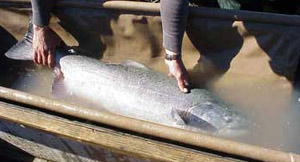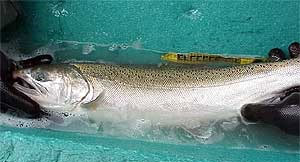Haines-Skagway Management Area
Fishing Research
Chilkat River Salmon Research
 The Alaska Department of Fish and Game (ADF&G) Division of Sport Fish leads Chinook (king) and coho (silver) salmon research projects on the Chilkat River. The ADF&G Division of Commercial Fisheries leads the sockeye (red) salmon and chum (dog) salmon research projects on the Chilkat and Chilkoot Rivers. ADF&G fishery managers use the production and harvest estimates from these projects to ensure sustained yield from local salmon stocks.
The Alaska Department of Fish and Game (ADF&G) Division of Sport Fish leads Chinook (king) and coho (silver) salmon research projects on the Chilkat River. The ADF&G Division of Commercial Fisheries leads the sockeye (red) salmon and chum (dog) salmon research projects on the Chilkat and Chilkoot Rivers. ADF&G fishery managers use the production and harvest estimates from these projects to ensure sustained yield from local salmon stocks.
Chilkat River Chinook Salmon Stock Assessment
 Prior to 1991, aerial Chinook salmon counts were conducted in two clear water (non-glacial) tributary streams: Stonehouse Creek and Big Boulder Creek. Radio tagging studies in 1991 and 1992 found that the number of spawners in these two streams represented less than 5% of the total Chilkat River run, and the aerial counts did not accurately estimate total abundance.
Prior to 1991, aerial Chinook salmon counts were conducted in two clear water (non-glacial) tributary streams: Stonehouse Creek and Big Boulder Creek. Radio tagging studies in 1991 and 1992 found that the number of spawners in these two streams represented less than 5% of the total Chilkat River run, and the aerial counts did not accurately estimate total abundance.
Since 1991, Chilkat River Chinook salmon runs have been estimated by an annual adult mark-recapture study, where fish are marked with tags near Haines Highway milepost 9 in June and July, then fish are recaptured in the headwater spawning streams in August to determine what fraction of the population was marked. The annual inriver run has averaged about 3,800 large (5-year old and older) Chinook salmon since 1991.
ADF&G manages upper Lynn Canal fisheries to meet a biological escapement goal range of 1,750 to 3,500 large Chilkat River Chinook salmon. This goal range was adopted by the Alaska Department of Fish and Game and the Alaska Board of Fisheries in 2003, and subsequently accepted by the Chinook Technical Committee of the Pacific Salmon Commission in 2004.
Since 2000, juvenile Chinook salmon have been captured in the Chilkat River drainage and marked with coded -wire tags (CWT) and clipped adipose fins. The fin clips and CWTs allow Chilkat River fish, along with other CWTd stocks, to be identified in commercial, sport, and subsistence marine fisheries. Random sampling of marine fisheries and the escapement allows ADF&G to estimate marine fishery harvest, marine survival, fresh water production, and total return of the Chilkat River stock. Average annual production parameters for spawning years 1999 through 2005 are: the Chilkat River produced 160,000 smolts, 3.2% of these smolts survived in marine waters to be adults, 18% of the adults were harvested in marine fisheries, and the remaining adults have returned to spawn in the Chilkat River.
Chilkat River Chinook salmon stock assessment projects are currently funded by the Chinook Salmon Research Initiative. Peer-reviewed results of the stock assessment project are published in annual Fishery Data Series reports, available in ADF&G’s searchable publications database.
Chilkat River Coho Salmon Stock Assessment
 Adult coho salmon enter the Chilkat River from August through November, and they spawn from October through January. Each fall, when glacial melt stops, the Chilkat River becomes less turbid, the water level drops, and spawning coho salmon can be visually counted in spawning tributaries. ADF&G has been using annual counts in 4 tributary streams to estimate coho salmon escapement since 1987. To calibrate these index area counts, mark-recapture studies of the coho salmon escapement have been conducted in five years: 1990, 1998, 2002, 2003, and 2005. Results from these studies indicate that the index area counts represent about 3.2% of the drainage-wide adult coho salmon escapement.
Adult coho salmon enter the Chilkat River from August through November, and they spawn from October through January. Each fall, when glacial melt stops, the Chilkat River becomes less turbid, the water level drops, and spawning coho salmon can be visually counted in spawning tributaries. ADF&G has been using annual counts in 4 tributary streams to estimate coho salmon escapement since 1987. To calibrate these index area counts, mark-recapture studies of the coho salmon escapement have been conducted in five years: 1990, 1998, 2002, 2003, and 2005. Results from these studies indicate that the index area counts represent about 3.2% of the drainage-wide adult coho salmon escapement.
Juvenile coho salmon that are incidentally caught during the spring Chilkat River Chinook salmon coded-wire tag effort are also marked with a CWT bearing a separate code and a clipped adipose fin. Like the Chinook salmon, the coho salmon CWTs allow ADF&G to estimate annual smolt production, marine fishery harvest, marine survival, and total return of the Chilkat River stock. Average production parameters for return years 2000-2011 are: 1.3 million smolts left the Chilkat River each spring, of which 11% survived 1 winter in the ocean to become adults, 41% of adults were harvested in marine fisheries, and 82,000 adults returned to the Chilkat River spawning grounds.Â
ADF&G manages coho salmon fisheries in Southeast Alaska to meet a biological escapement goal range of 30,000 to 70,000 Chilkat River coho salmon. Peer-reviewed results of the stock assessment project are published in annual Fishery Data Series reports, available in ADF&G’s searchable publications database.
Other Salmon Studies
 The Division of Commercial Fisheries conducts annual mark-recapture studies of adult sockeye salmon in the Chilkat River drainage. In addition, a DIDSON sonar counting system counts adult sockeye entering Chilkat Lake, and a weir is used to count adult sockeye salmon returning to Chilkoot Lake. The Division of Commercial Fisheries uses fish wheels near Haines Highway milepost 9 as an index of chum salmon escapement to the Chilkat River drainage. Inseason and historic sockeye salmon counts from these projects are available online.
The Division of Commercial Fisheries conducts annual mark-recapture studies of adult sockeye salmon in the Chilkat River drainage. In addition, a DIDSON sonar counting system counts adult sockeye entering Chilkat Lake, and a weir is used to count adult sockeye salmon returning to Chilkoot Lake. The Division of Commercial Fisheries uses fish wheels near Haines Highway milepost 9 as an index of chum salmon escapement to the Chilkat River drainage. Inseason and historic sockeye salmon counts from these projects are available online.
ADF&G continues to partner with local watershed groups and volunteer groups to update the Anadromous Waters Catalog and to do habitat assessment and improvement in the Haines/Skagway management area.
